Japan
Wood Products Prices
Dollar Exchange Rates of 25th
July 2017
Japan Yen 111.9
Reports From Japan
Labour productivity lower than other major
developed
economies
The Cabinet Office monthly economic report for July
states that the Japanese economy remains in a "moderate
recovery," mode with both consumption and capital
investment expanding.
However, last month the report said producer prices were
rising moderately but the July edition said this pace of
increase has eased.
Two issues are behind this change in language the slowing
in oil prices and suggestions that growth in global
consumption has weakened and that this will be
exacerbated by the impact in the EU of Brexit and the
knock on effect on imports.
According to a review by the government on the economy
and finances for fiscal 2017, to achieve sustained growth
Japan needs to address its severe labour shortage as well
as productivity which is lower than in other major
developed economies.
See:
https://japantoday.com/category/business/labor-shortage-poseschallenge-
to-japan%27s-economic-growth-report
and
http://www5.cao.go.jp/keizaishimon/
kaigi/cabinet/2017/2017_basicpolicies_en.pdf
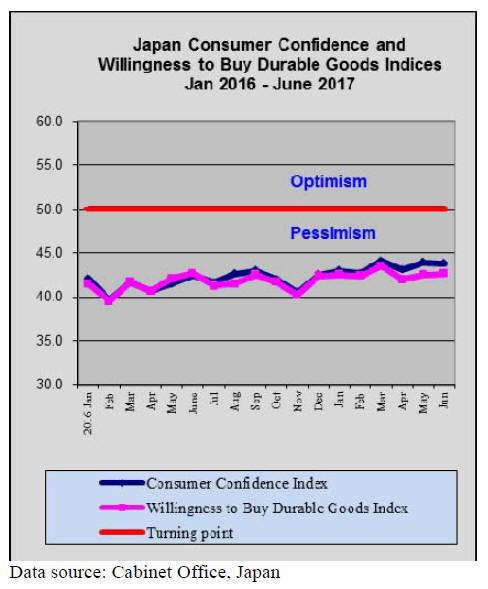
Bank of Japan stands out alone
Despite moves by most other central banks to raise interest
rates, the Bank of Japan (BoJ) looks set to maintain its
zero interest rate for as long as possible.
At its latest meeting the BoJ reaffirmed commitment
to its
unconventional monetary policy pledging to continue its
monetary easing. In mid-July the yen was at its lowest
level against the US dollar in four months close to lows at
levels not seen since the end of last year.
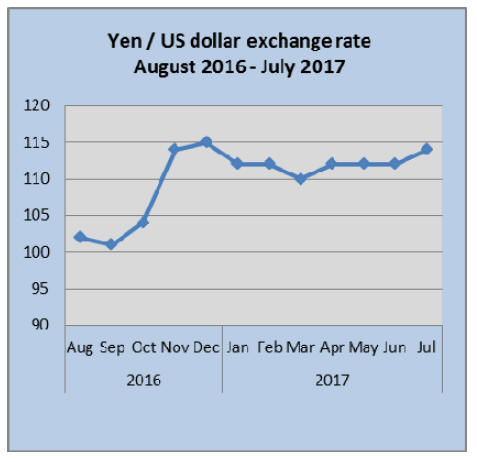
Japan¡¯s wooden furniture imports
For the first time in several months the value of Japan¡¯s
furniture imports exhibit a level of consistency. Wooden
bedroom furniture imports in May expanded 17% and
imports of office and kitchen furniture rose slightly.
While kitchen furniture imports have been rising steadily,
imports of office and bedroom furniture have been more
erratic. Looking back several years the impact of the lunar
holiday period in both China and Vietnam, both major
furniture suppliers to Japan, is very apparent with
shipments around this period dropping significantly.
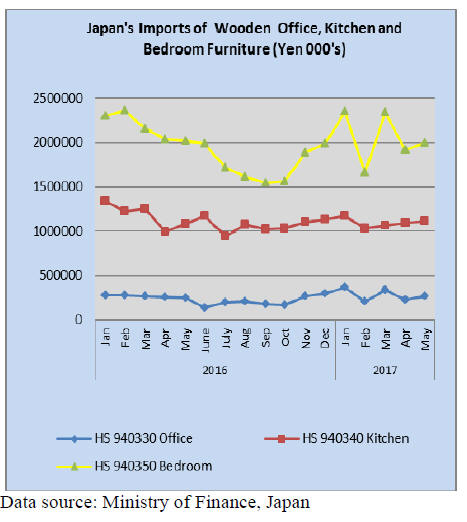
Office furniture imports (HS 940330)
Year on year May imports of wooden office furniture were
up 8% and month on month imports rose 17%. China,
Portugal and Italy dominate Japan¡¯s wooden office
furniture imports accounting for over 80% of May
imports.
In May this year imports from China fell slightly but still
accounted for 67% of all wooden office furniture imports.
Imports from Portugal and Italy are small compared to
those from China (around 8% each).
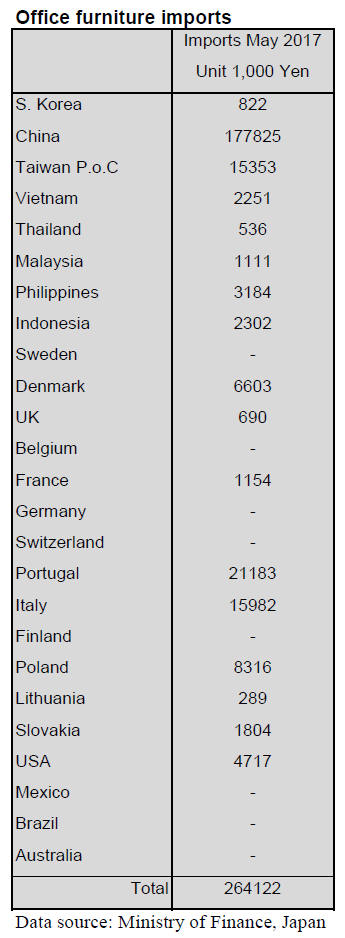
Kitchen furniture imports (HS 940340)
The top three shippers of kitchen furniture to Japan,
Vietnam, the Philippines and China accounted for 82% of
May imports of this category of furniture.
Manufactures in Vietnam, many of which are joint
ventures with Japanese companies have established itself
as the main suppliers of wooden kitchen furniture to the
Japanese market.
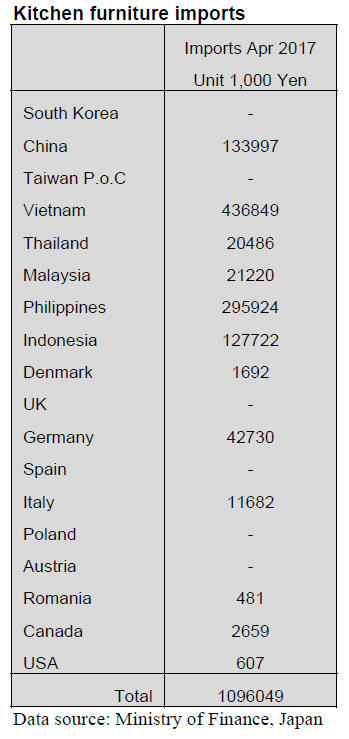
Year on year, imports of wooden kitchen furniture
rose
only marginally in May and a similar pattern was seen
with month on month imports. Shippers in Vietnam
accounted for just over 40% of Japan¡¯s May wooden
kitchen furniture imports followed by the Philippines
(29%) and China (11%).
Bedroom furniture imports (HS 940350)
The volatility in the value of Japan¡¯s imports of wooden
bedroom furniture reflects to drop in trade from both
China and Vietnam in the early part of the year when the
Lunar holidays take place. If average imports for the first
five months of 2016 and 2017 are compared it can be seen
there was little change in the overall value. 2017 imports
just edged out those for 2016.
In May the three main shippers, China, Vietnam and
Thailand accounted for around 90% of Japan¡¯s imports of
wooden bedroom furniture. Imports from China were flat
compared to a month earlier but imports from Vietnam
and Thailand rose (8% and 11% respectively).
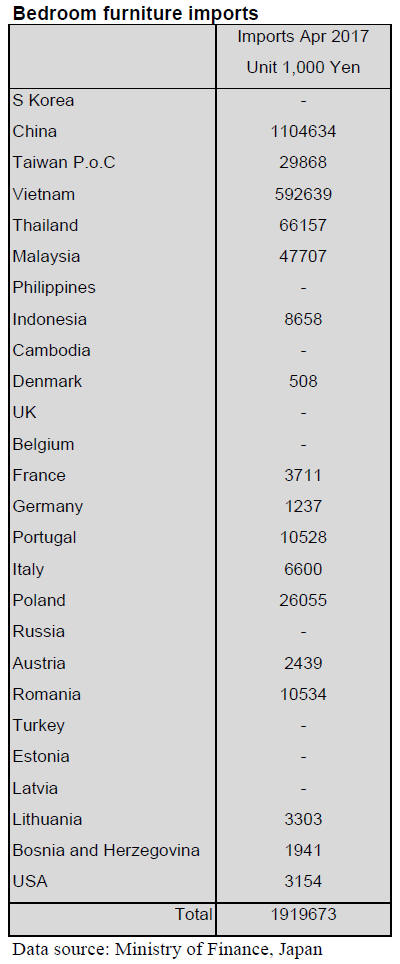
Trade news from the Japan Lumber Reports (JLR)
For the JLR report please see:
http://www.nmokuzai.
com/modules/general/index.php?id=7
Problem of South Sea log supply ¨C a look at the log
trade
Malaysia¡¯s Sarawak provincial government decided to
impose timber premium since July 1, which is one of log
harvest duties. Cost of logs of both hill logs and swamp
logs is up by about US$12 per cbm. Export log suppliers
and local plywood mills are proposing higher prices with
this new duty.
Looking at history of South Sea log trade, hardwood logs
were used for plywood manufacturing in Japan since
1960s and imported volume in 1973 reached 2,700,000
cbms. Japan used lauan logs from Philippines first then
after Philippine¡¯s resource dried up, Japan move to
Indonesia to import meranti then to Malaysia to use
serayah.
Japan had been looking for quality hardwood logs for all
these years but now the import volume dropped down to
200,000 cbms a year but plywood import has been
continuing at high level, which takes about 50% of
plywood demand in Japan. In 2016, total plywood import
was 2,77,000 cbms out of which Malaysian supply was
1,075,000 cbms and Indonesian was 90,000 cbms.
Mainly Malaysian plywood is used for concrete forming
and Indonesian plywood is used for floor base in Japan. So
for Japan, plywood supply from Malaysia is bigger issue
than log import.
In the past, when the new regulation such as timber
premium enters into force, normally there had been some
grace period of six months to one year but this time,
timber premium duty is imposed immediately since July1.
Log exporters and local plywood mills would buy logs
ahead of time before the new duty is imposed but there
have been various restrictions for log harvest such as
monthly harvest quota and diameter restriction, which
prohibits harvest of logs with less than 50 cm in diameter
at breast high so rush-in log purchase was impossible.
After all, decline of resources is the biggest problem
together with chronic labor shortage and harvest
restrictions by the government.
As to log import from Malaysia, India is now dominant
buyer so Japan has no control on export log prices. Then
looking at steady export price increase of Malaysian and
Indonesian plywood, Japanese industries have been
gradually shifting necessary materials from imports to
domestic supply.
Actually Japanese plywood mills have been manufacturing
concrete forming and floor base plywood with domestic
cedar.
Temperate hardwood demand rising
Orders on temperate hardwood products from North
America are increasing particularly for interior use like
flooring of large buildings. This is not seasonal demand
pickup but by construction of hotels for 2020 Tokyo
Olympic Games. Also public halls like music halls
traditionally refurbish during summer.
Ordered items are white ash, oak and walnut. Sawmills say
that there are more orders for flooring but they are not for
new building but refurbishing demand. Supply from North
America is scarce but there is more supply from Eastern
Europe, which is now source. Chinese demand for
furniture and interior materials continues steady. The
prices of hardwood products are unchanged. Red oak
lumber prices are about 129,000 yen.
Action plan to expand wood products exports
Wood products export strategy committee of the Ministry
of Agriculture, Forestry and Fisheries came up with the
action plan to expand wood products export.
In May 2016, by strategy to increase export of agricultural
products, the policy has changed from log export to value
added lumber export to China, Taiwan and Korea. This
time, Vietnam is newly added as new market. Then it sets
target volume to each country.
The Ministry¡¯s target is to expand total value of export of
agricultural and marine products from about 450 billion
yen in 2016 to 1,000 billion yen in 2020. In this, forest
products export value in 2012 was 12 billion yen then 25
billion yen in 2020 but it was 27 billion yen in 2015 so it
has exceeded the target already. To achieve target of 1,000
billion yen, further expansion of forest products export is
required.
Cedar export has been mainly low grade, low price logs
for China. To promote export of value added lumber, it is
necessary to improve degree of recognition of Japanese
cedar and find out needs of the markets.
It is necessary to develop new products to particular
markets of building and interior materials by using high
manufacturing technology of Japanese mills, which needs
to deal with the Chinese Building Standards then promote
propaganda with permanent exhibition halls.
In sales promotion, building of model house, finding local
partners, local builders and tie-up with local forest unions
to build up log distribution system in foreign markets.
Branding of Japanese cypress with characteristic of the
species and health effect is another campaign target. Korea
likes Japanese cypress with health effect by activating
physiological function of the species so it is mainly used
for interior materials and furniture .So far, log export is
main for cypress so cypress lumber export is the challenge
and finds a new market besides Korea.
New propaganda has started in other markets and China
seems to be promising market for cypress for interior and
furniture use.
Plywood
Supply tightness of domestic softwood plywood has been
solved in majority of areas in Japan and there
were some low prices were offered in June but orders from
major precutting plants have started increasing in July so
the market prices are firm again.
May softwood plywood production was 242,800 cbms,
8.3% more than May last year and 3.7% less than April
with the shipment of 240,000 cbms, 3.0% more and 4.6%
less. The inventories were 91,300 cbms, 2,500 cbms
increase from April, only 38% of monthly shipment.
The market prices of imported plywood have been
gradually moving up by sharp increase of suppliers¡¯ export
prices despite dull movement.
Dealers and contractors started procuring with outlook of
price increase in future. May imported plywood volume
was 257,600 cbms, 11.0 % more and 10.0% more. The
importers try to buy futures with declining port inventories
but the market prices in Japan have always been behind
suppliers¡¯ proposed prices so they hesitate to commit.
The suppliers continue suffering log supply shortage so
the shipments are behind schedule of more than a month
so there is a chance that the inventories in Japan may drop
sharply.
 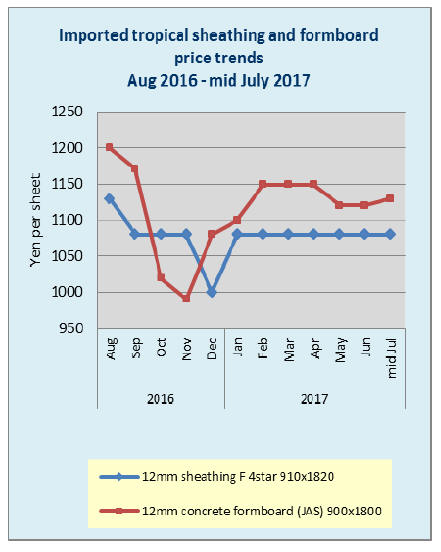
|